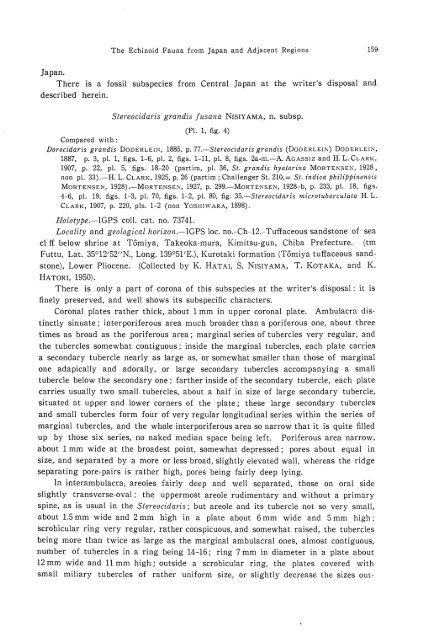the echinoid fauna from japan and adjacent regions part i
the echinoid fauna from japan and adjacent regions part i
the echinoid fauna from japan and adjacent regions part i
You also want an ePaper? Increase the reach of your titles
YUMPU automatically turns print PDFs into web optimized ePapers that Google loves.
The Echinoid Fauna <strong>from</strong> Japan <strong>and</strong> Adjacent Regions<br />
Japan.<br />
There is a fossil subspecies <strong>from</strong> Central Japan at <strong>the</strong> writer's disposal <strong>and</strong><br />
described herein.<br />
Stereocidaris gr<strong>and</strong>is jusana NISIY AMA, n. subsp.<br />
(PI. 1, fig. 4)<br />
Compared with:<br />
Dorocidaris gr<strong>and</strong>is DODERLEIN, 1885, p. 77.-Stereocidaris gr<strong>and</strong>is (DODERLEIi\:) DODERLEI:-':,<br />
1887, p. 3, pI. 1, figs. 1-6, pI. 2, figs. 1-11, pI. 8, figs. 2a·m.-A. AGASSIZ <strong>and</strong> H. L. CLARK,<br />
1907, p. 22, pI. 5, figs. 18-20 (<strong>part</strong>im, pI. 36, St. gr<strong>and</strong>is hyatorina MORTEi\:SEJ':, 1928,<br />
non pI. 33) .-H. L. CLARK, 1925, p. 26 (<strong>part</strong>im ; Challenger St. 210,= St. indica Philippinensis<br />
MORTENSEN, 1928).-MoRTENSEi\:, 1927, p. 299.-MoRTENSEN, 1928-b, p. 233, pI. 18, figs.<br />
4-6, pI. 19, figs. 1-3, pI. 70, figs. 1-2, pI. 80, fig. 35.-Stereocidaris microtuberculata H. L.<br />
CLARK, 1907, p. 220, pis. 1-2 (non YOSHIWARA, 1898).<br />
Holotype.-IGPS colI. cat. no. 73741.<br />
Locality <strong>and</strong> geological horizon.-IGPS loco no.-Ch-12.-Tuffaceous s<strong>and</strong>stone of sea<br />
c1.ff below shrine at T6miya, Takeoka-mura, Kimitsu·gun, Chiba Prefecture. (tm<br />
Futtu, Lat. 35°12'52/1N., Long. 139°51'E.), Kurotaki formation (T6miya tuffaceous s<strong>and</strong>stone),<br />
Lower Pliocene. (Collected by K. HATAI, S. NISIYAMA, T. KOTAKA, <strong>and</strong> K.<br />
HATORI, 1950).<br />
There is only a <strong>part</strong> of corona of this subspecies at <strong>the</strong> writer'S disposal: it is<br />
finely preserved, <strong>and</strong> well shows its subspecific characters.<br />
Coronal plates ra<strong>the</strong>r thick, about 1 mm in upper coronal plate. Ambulacra distinctly<br />
sinuate; interporiferous area much broader than a poriferous one, about three<br />
times as broad as <strong>the</strong> poriferous area; marginal series of tubercles very regular, <strong>and</strong><br />
<strong>the</strong> tubercles somewhat contiguous; inside <strong>the</strong> marginal tubercles, each plate carries<br />
a secondary tubercle nearly as large as, or somewhat smaller than those of marginal<br />
one adapically <strong>and</strong> adorally, or large secondary tubercles accompanying a small<br />
tubercle below <strong>the</strong> secondary one; far<strong>the</strong>r inside of <strong>the</strong> secondary tubercle, each plate<br />
carries usually two small tubercles, about a half in size of large secondary tubercle,<br />
situated at upper <strong>and</strong> lower corners of <strong>the</strong> plate; <strong>the</strong>se large secondary tubercles<br />
<strong>and</strong> small tubercles form four of very regular longitudinal series within <strong>the</strong> series of<br />
marginal tubercles, <strong>and</strong> <strong>the</strong> whole interporiferous area so narrow that it is quite filled<br />
up by those six series, no naked median space being left. Poriferous area narrow,<br />
about 1 mm wide at <strong>the</strong> broadest point, somewhat depressed; pores about equal in<br />
size, <strong>and</strong> separated by a more or less broad, slightly elevated wall, whereas <strong>the</strong> ridge<br />
separating pore· pairs is ra<strong>the</strong>r high, pores being fairly deep lying.<br />
In interambulacra, areoles fairly deep <strong>and</strong> well separated, those on oral side<br />
slightly transverse-oval; <strong>the</strong> uppermost areole rudimentary <strong>and</strong> without a primary<br />
spine, as is usual in <strong>the</strong> Stereocidaris; but areole <strong>and</strong> its tubercle not so very small,<br />
about 1.5 mm wide <strong>and</strong> 2 mm high in a plate about 6 mm wide <strong>and</strong> 5 mm high;<br />
scrobicular ring very regular, ra<strong>the</strong>r conspicuous, <strong>and</strong> somewhat raised, <strong>the</strong> tubercles<br />
being more than twice as large as <strong>the</strong> marginal ambulacral ones, almost contiguous,<br />
number of tubercles in a ring being 14-16; ring 7 mm in diameter in a plate about<br />
12 mm wide <strong>and</strong> 11 mm high.; outside a scrobicular ring, <strong>the</strong> plates covered with<br />
small miliary tubercles of ra<strong>the</strong>r uniform size, or slightly decrease <strong>the</strong> sizes out-<br />
159












